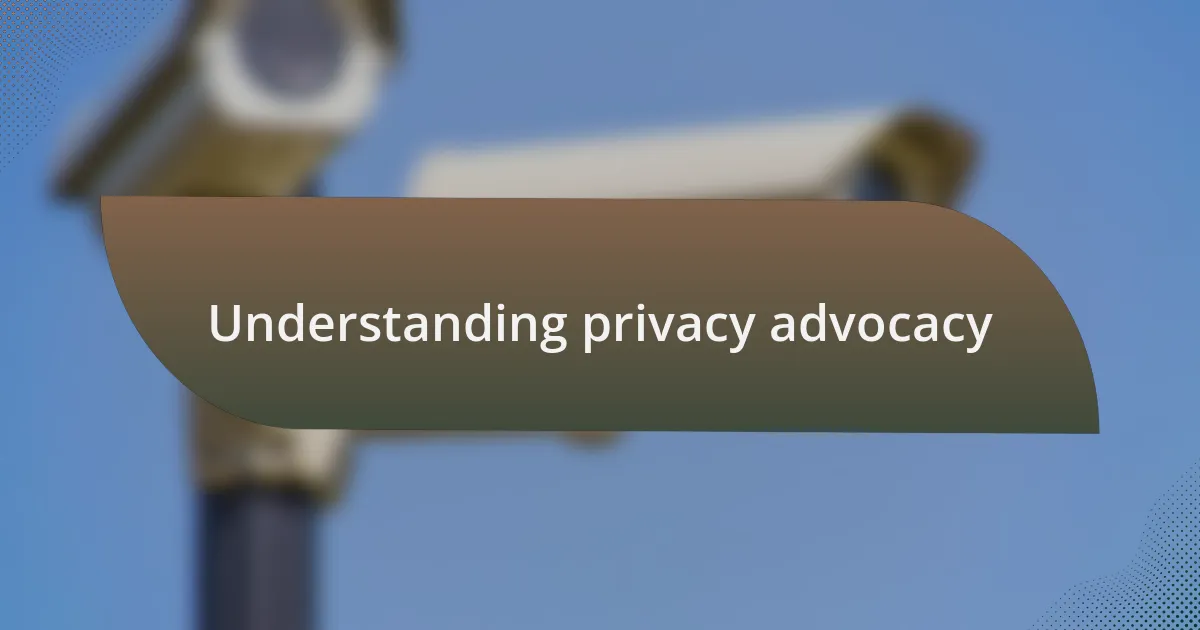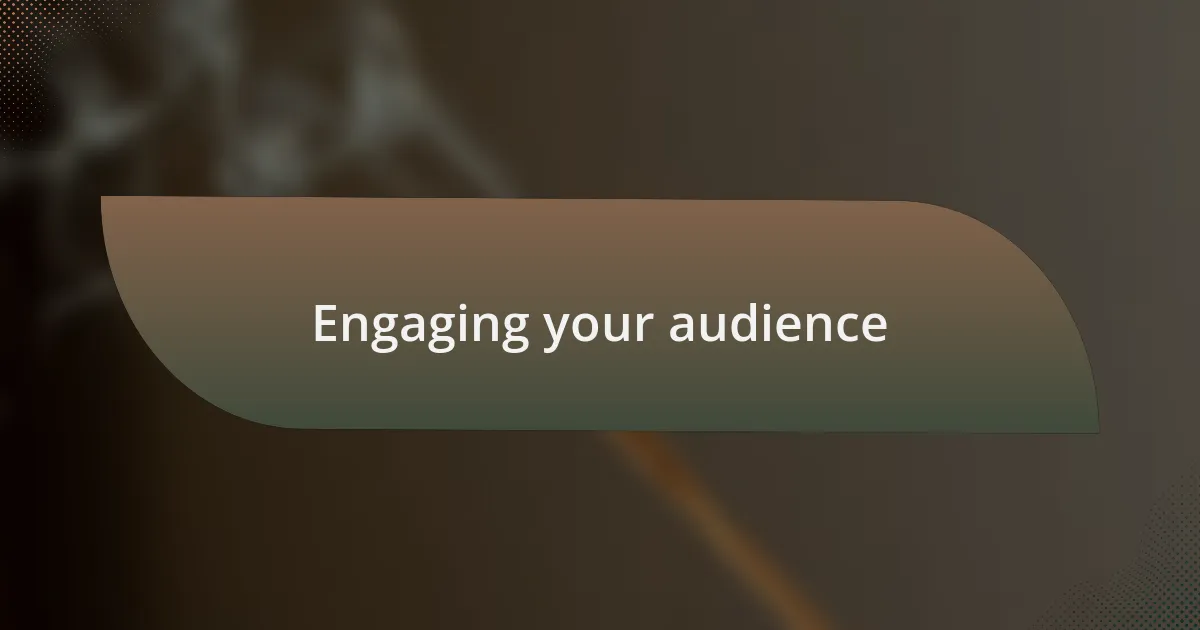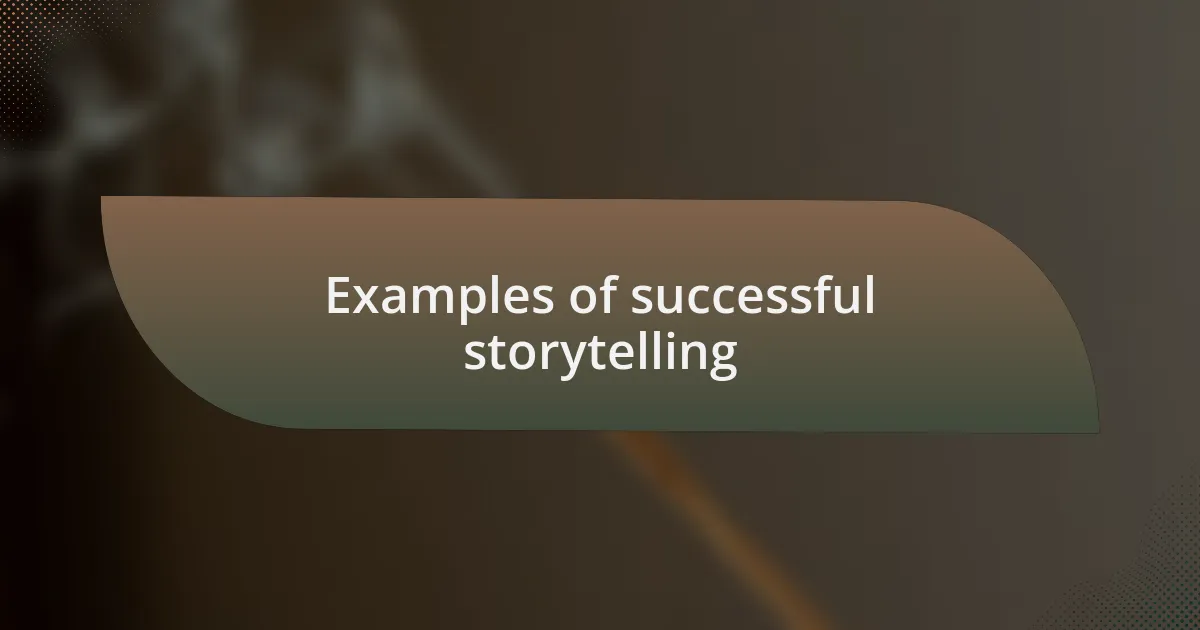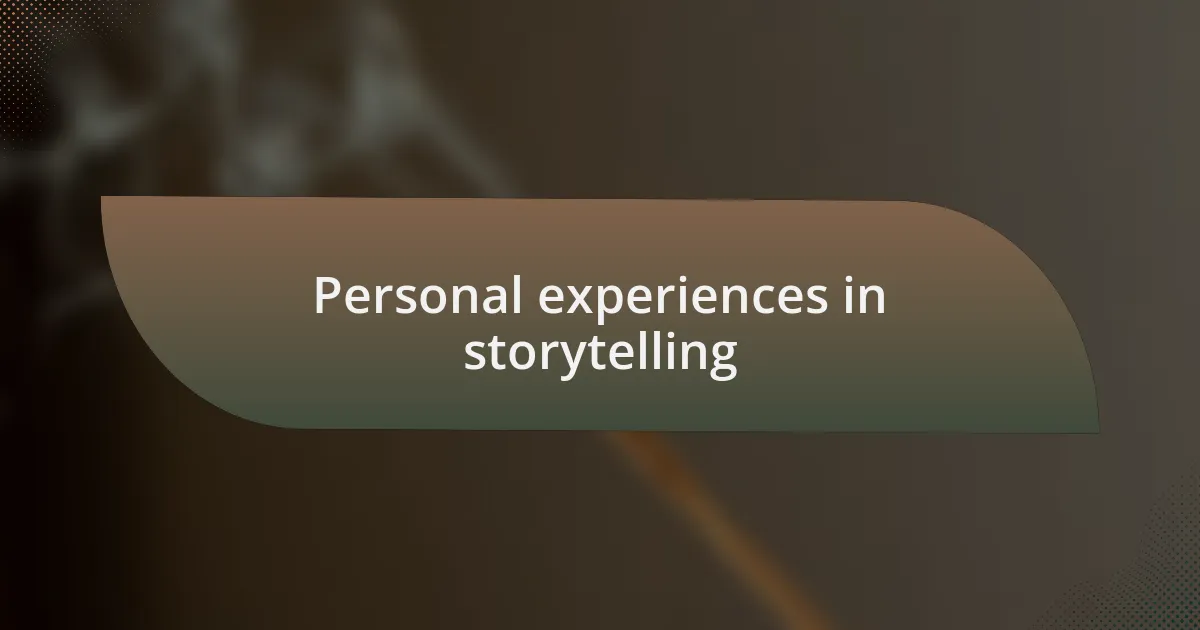Key takeaways:
- Privacy advocacy raises awareness about personal data protection, emphasizing the importance of understanding digital footprints.
- Storytelling is crucial for connecting complex privacy issues to personal experiences, fostering empathy and engagement.
- Effective storytelling techniques, such as using vivid imagery and rhetorical questions, enhance audience connection and reflection.
- Sharing personal experiences creates a sense of community and encourages open dialogue about digital privacy challenges.

Understanding privacy advocacy
Privacy advocacy is all about raising awareness about the importance of personal data protection and the right to privacy. I remember a time when I shared a post on social media, unaware of the fine print that allowed my data to be sold. It made me wonder: how well do we really understand the implications of our digital footprints?
In my experience, privacy advocacy often feels like a battle against big corporations that prioritize profit over people’s rights. I still recall a conversation with a friend who was blissfully ignorant of the tracking apps on her phone. When I explained how much data they collected, I could see her realization dawning—it’s these moments that highlight the urgent need for advocacy.
Engaging individuals in this conversation can be challenging, yet rewarding. I often ask people how they feel when they realize they’re being watched online. Their responses range from discomfort to apathy, revealing just how vital it is to tailor our storytelling around relatable experiences. Each narrative can spark curiosity and inspire a more conscious approach to privacy.

Importance of storytelling
Storytelling serves as a powerful vehicle for connecting complex ideas, like privacy advocacy, to our everyday realities. I remember sharing a story about my own experience with phishing scams during a community workshop. As I recounted the fear and helplessness I felt when I discovered my personal information was compromised, I saw heads nodding in recognition. That moment made me realize that stories can break down barriers and engage emotions, propelling people to consider the sometimes-invisible threats to their privacy.
Each story can also create a sense of urgency that facts alone may not convey. I often ask myself, “What if that data breach was not just a statistic, but a neighbor’s life turned upside down?” Bringing a human element into discussions about data protection encourages listeners to perceive these issues on a deeper level. When we weave real-life experiences into our advocacy, we can shift mindsets and inspire action by showing the tangible impacts privacy violations have on individuals.
Furthermore, sharing stories fosters a sense of community and shared experience. I’ve noticed that when I open up about my struggles with digital privacy, others feel empowered to share their own concerns. This exchange not only strengthens our collective voice but also positions storytelling as a vital tool for advocacy, transforming personal experiences into a collective call for change.

Techniques for effective storytelling
One effective technique for storytelling is to use vivid imagery to paint a picture in the listener’s mind. I recall sharing a story about how I discovered a strange charge on my credit card late one night. By describing the dim light of my living room, the racing thoughts in my mind, and the sinking feeling in my stomach, I could evoke emotions in my audience. This technique not only makes the story more relatable but allows others to feel what I felt, drawing them closer to the topic at hand.
Another powerful approach is to pose rhetorical questions that challenge your audience’s assumptions. I once asked, “What would you do if your entire online identity vanished overnight?” This question lingered in the air, prompting listeners to reflect on their own experiences with digital security. Engaging them in this way transforms passive listeners into active participants, encouraging them to think critically about their own privacy practices.
Incorporating twists and turns in your narrative can also keep the audience engaged. I remember recounting a time I narrowly avoided a data breach due to a friend’s advice. I built suspense around my decision-making process, which kept everyone on the edge of their seats. By weaving unexpected elements into my stories, I ensure that they not only inform but also entertain, making a lasting impact on those who hear them.

Engaging your audience
To truly engage your audience, it’s vital to tap into their emotions and experiences. For instance, I shared a story about a moment I felt utterly powerless after realizing my personal data had been compromised. Describing my frantic search for answers and the weight of anxiety that settled over me resonated with listeners who had faced similar fears. When I could see their nodding heads and empathetic expressions, I knew we were connected through shared emotions.
A great way to pull your audience in is to invite them into the narrative. I often ask, “Have you ever felt your heart race when reading a terms and conditions agreement?” This simple question encourages them to recall their own experiences and immediately fosters a sense of camaraderie. By making your audience reflect on their own stories, you create a bond that enhances their investment in what you’re sharing.
Moreover, storytelling becomes more impactful when you reveal vulnerabilities. I once opened up about the shame I felt after ignoring privacy settings on my social media accounts. This kind of honesty not only humanizes the narrative but also makes it clear that I, too, am learning and growing. It reminds the audience that they are not alone in their challenges. Engaging them in this way invites dialogue and encourages them to consider their own privacy habits in a more serious light.

Examples of successful storytelling
When I think about successful storytelling, I remember a time when I shared a tale about a friend who suffered a security breach. Describing the sheer disbelief on their face as they discovered unauthorized charges on their credit card struck a chord with my audience. The emotions of frustration and betrayal were palpable, and I saw many nodding in recognition—their own experiences mirrored my friend’s.
Another powerful example that stands out is when I recounted an instance during a panel discussion about a data leak in a well-known company. I painted a vivid picture of the chaos that ensued, highlighting the frustration of employees and customers alike. This narrative created a shared moment of outrage, inviting others to reflect on their feelings toward corporate accountability in the digital age.
I also like to illustrate the power of storytelling through a charity event I hosted where we collected personal stories about data privacy violations. Each tale—complete with detailed emotions and consequences—moved the audience deeply, prompting them to consider not just statistics but real human experiences. As I wrapped up, I asked, “How many of us have felt this kind of injustice?” The silence that followed spoke volumes, reinforcing the idea that personal stories can rally us together around a common cause.

Personal experiences in storytelling
When I reflect on my own experiences with storytelling, I remember an intimate gathering where I shared my journey of navigating privacy settings on social media. I described the anxiety I felt as I toggled each option, fearing that one wrong click could expose my life to the world. The audience’s collective sigh revealed a shared vulnerability; they were all wrestling with the same fears, connecting over the universal struggle of safeguarding our personal information.
One evening, while volunteering at a local community center, I narrated a story about an elderly neighbor who had fallen victim to identity theft. As I recounted her disbelief and the subsequent struggle to regain her sense of security and trust in technology, I noticed several heads nodding and expressions of empathy surfacing. This reinforced my belief that personal stories evoke emotions that statistics alone cannot—how could anyone listening not feel for her plight?
During an online workshop on digital privacy, I shared a moment when I felt completely lost in the maze of user agreements. I asked the attendees, “Have you ever felt paralyzed by the sheer volume of information you’re supposed to absorb?” A wave of recognition swept across their faces, as many shared their own frustrations. It dawned on me that storytelling isn’t just about sharing experiences—it’s about creating a space where others feel empowered to share theirs too, bridging the gap between the speaker and the audience.

Tips for improving storytelling skills
To enhance your storytelling skills, start by understanding your audience and tailoring your narrative to resonate with their experiences. I recall a time when I shared a compelling anecdote about a friend’s encounter with a data breach, relating it to our shared concerns. The eyes peering back at me said it all; they were not just listening—they were reflecting on their own experiences, which forged a stronger connection.
Another effective tip is to weave in sensory details that transport your audience into your story. For instance, while discussing data privacy struggles, I vividly described the cluttered desk and the endless notifications buzzing around me. This not only painted a clear picture but also sparked further discussions among listeners who had faced similar digital chaos. Don’t you find that when you can almost feel the moment, your engagement deepens?
Finally, don’t shy away from using pauses strategically during your storytelling. I’ve found that a well-timed pause after sharing a shocking statistic or an emotional point allows the weight of those words to fully resonate. It gives the audience a moment to digest, reflect, and connect more deeply with the narrative. Have you noticed how silence can sometimes speak louder than words, inviting deeper engagement?